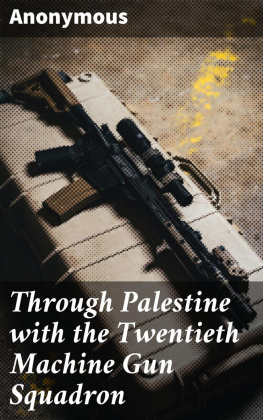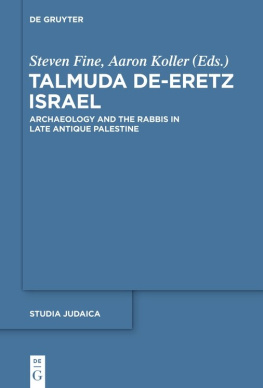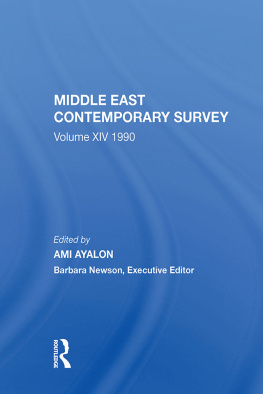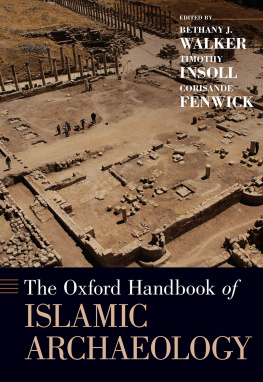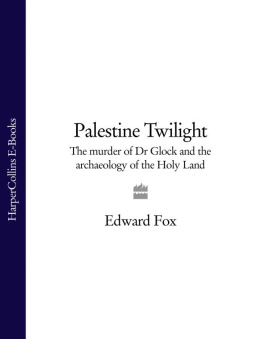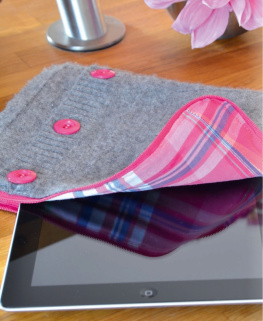First published 2006 by Left Coast Press Inc.
Published 2016 by Routledge
2 Park Square, Milton Park, Abingdon, Oxon OX14 4RN
711 Third Avenue, New York, NY 10017, USA
Routledge is an imprint of the Taylor & Francis Group, an informa business
Copyright 2006 Presses Universitaires de France
This is an English translation of Art et archologie islamiques en Palestine, published in 2002 by Presses Universitaires de France.
Translated by E. Singer.
All rights reserved. No part of this book may be reprinted or reproduced or utilised in any form or by any electronic, mechanical, or other means, now known or hereafter invented, including photocopying and recording, or in any information storage or retrieval system, without permission in writing from the publishers
Notice:
Product or corporate names may be trademarks or registered trademarks, and are used only for identification and explanation without intent to infringe.
Library of Congress Cataloging-in-Publication Data
Rosen-Ayalon, Myriam.
[Art et archologie islamiques en Palestine. English] Islamic art and archaeology in Palestine / Myriam Rosen-Ayalon ; translated by Esther Singer.
p. cm.
Includes bibliographical references and index.
ISBN-13: 978-1-59874-063-9 (hardback : alk. paper)
ISBN-10: 1-59874-063-6 (hardback : alk. paper)
ISBN-13: 978-1-59874-064-6 (pbk. : alk. paper)
ISBN-10: 1-59874-064-4 (pbk. : alk. paper)
1. PalestineAntiquities. 2. Art, IslamicPalestine. 3. Islamic antiquitiesPalestine. 4. ArchaeologyPalestine. I. Title.
DS111.1.R6713 2006 709.56940902dc22 2006014613
ISBN 13: 978-1-59874-064-6 (pbk)
ISBN 13: 978-1-59874-063-9 (hbk)
I SLAMIC ARCHAEOLOGY is one of the newest branches in this field and has only recently received official recognition. This applies to the study of Palestine as well as the surrounding areas, and helps explain the care needed when presenting an overview of this subject.
The geographical region covered by this book corresponds to the area west of the Jordan River, which does not coincide with any historical political entity. The Islamic art and archaeology that developed in this region cannot be separated from its geographic and cultural context, and, as is the case everywhere, its defining characteristics did not emerge in a vacuum. The different phases of Islamic art resulted from shifts in centers of culture, and these influences had a great impact on Palestine, a true melting pot of political, cultural, and artistic energies. However strong these influences were, it would be a mistake to downplay local contributions to artistic production. The impact of these two forcesexternal and localis what we will follow throughout this volume.
This book is designed to be a first step in this field. Its objective is to present, for the first time, an overview of finds from excavations and the main monuments in the region, in order to provide a summary of the subject. The classification used here will, I hope, be a starting point for more in-depth studies, both in terms of phenomenological interpretation and for the study of its characteristics.
The complexity of the subject matter and the wealth of topics covered here for the first time call for some introduction. The artistic and archaeological material brought together in this book reveal a genuine local identity, and at this stage I will not enter into the controversies and debates that the chapters in this volume could spark. It is clear that in the future special comparative studies will be required, linking artistic expression in Palestine to art forms existing during the same time periods in other Islamic regions.
A great deal of thought went into the structure of this book. Studies of art and archaeology all differ as a function of the civilizations or the specific topic they cover. Certain authors elect to describe specific archaeological sites over different periods of time, such as a survey over time of Hama or Abu Gosh. Others prefer a thematic approach, for instance, the finds at Samarra, Qasr el-Qadim, or Nishapur. Still others base themselves primarily on chronology, as is the case for archaeology textbooks by W. P. Albright, A. Mazar, or T. Levy.
I believe this latter choice is the best suited for the material presented in this book. I thus discuss art forms and archaeological finds in the light of history, but without maintaining an overly rigid framework. In some cases I have used a thematic presentationfor instance, in the section on fortresses and the one dealing with the sugar industry. Nevertheless, I have carefully adhered to the chronological sequence of events.
I begin first of all by presenting the history and the archaeology of the country during the Jahiliya, the pre-Islamic period, although limited to the years immediately preceding this new epoch. As the Umayyads came to Palestine, heralding the first great era of Islamic civilization, a new wave of artistic expression was emerging in Damascus, the capital of the caliphate, one that was highly influenced by the legacy of the classical world.
During the next era, the Islamic entity took root and Egypt was the prime mover behind endeavors carried out in Palestine. Toward the end of the Middle Ages, Muslim art was subject to both Western and Eurasian influences. The enormous artistic activity of this period highlights the role of Palestines location between Syria and Egypt. However, when the country fell into the hands of the Ottoman Empire, there was a significant change, and the style of the court of Istanbul influenced the arts produced in Palestine.
The study of Islamic archaeology deserves several preliminary comments. In contrast to traditional or noble forms of archaeology, which deal with ancient civilizations, the archaeology of the Middle Ages is the most recent chapter in the field of archaeology. This trend is not specific to Palestine but rather reflects the field in general. The first archaeological excavations conducted by Western scholars in the mid-19th century focused on biblical topics or their associated traditions. Yet once the colonial period was over, the various Muslim countries maintained a similar archaeological policy for several decades. There was a race to discover ancient civilizations: the Egypt of the Pharaohs, Hittite Turkey, Achaemenid Persia, as well as Sumer, Akkad, Babylonia, and Phoenicia. Rather than examining the Muslim Middle Age, from which their current identities directly derive, all these countries were oriented toward the search for past glory going back thousands of years. Palestine and its biblical past were no exception.







